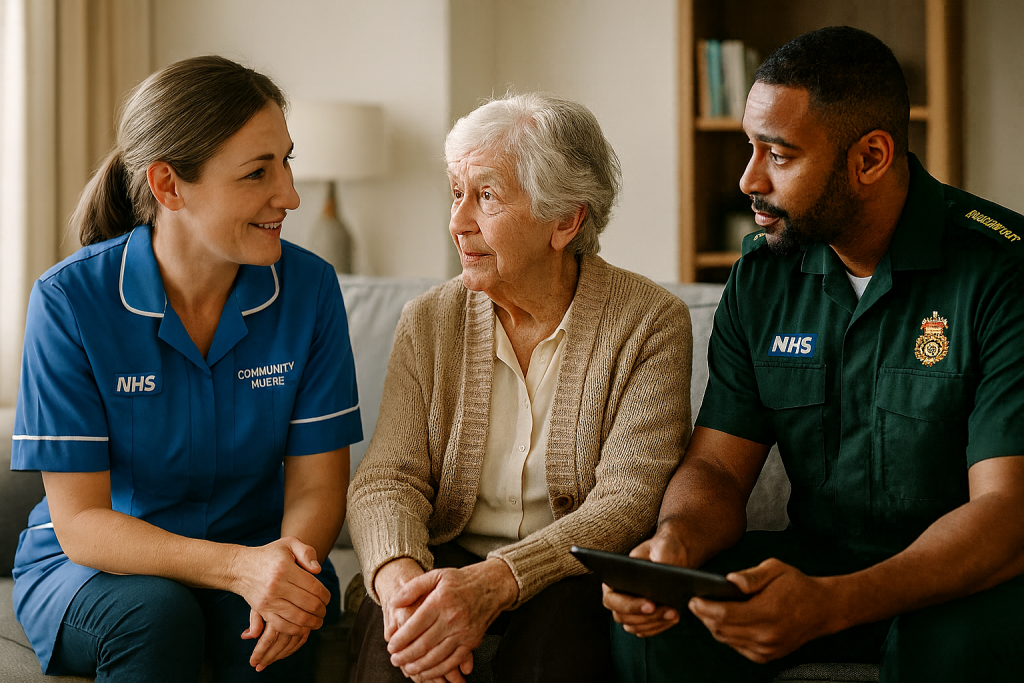UCR at 85%: what’s working — and How to Replicate It
4 Nov 2025 |
| Share with

Executive summary
- The signal: In June 2025, 85% of urgent community response (UCR) calls were met within 2 hours, beating the 70% national target.
- Why this matters: UCR is one of the few consistently improving services. It prevents avoidable admissions, supports ambulance handovers, and strengthens winter resilience.
- What to do now: Identify the success factors, integrated triage, multi-professional teams, digital visibility, and outcome-linked commissioning, and replicate them at scale.
Context & system signals
- The Integrated Performance Report (Sept 2025) places UCR alongside Cat-2 and DRD as critical flow measures.
- Performance has held above 80% nationally, making UCR a rare bright spot amid wider pressure. Its role in avoiding ED admissions and reducing discharge delays means it’s now a frontline resilience lever.
- The NHS Oversight Framework emphasises outcome-linked commissioning, which UCR exemplifies.
Strategic implications
- UCR proves integration works. Where systems align ambulance, primary care, and community response, results are measurable and consistent.
- Replication is urgent. Variation between ICSs is widening; winter resilience depends on copy-pasting the high-performing model.
- Commissioning must shift to outcomes. Admission avoidance, ED handover time, and patient experience are stronger levers than activity counts.
- Equity cannot be an afterthought. Without targeted outreach, deprived areas risk lower UCR access despite higher need.
Blueprint: scaling UCR
- Integrated triage with ambulance and primary care
- Single access points linking NHS 111, GPs, and ambulance crews.
- Outcome: seamless routing and fewer unnecessary conveyances.
- Multi-professional rapid response teams
- Nurses, therapists, paramedics, and social care in one pod.
- Outcome: holistic home stabilisation (frailty, falls, infections).
- Digital visibility of capacity
- Live dashboards to show UCR availability in real time.
- Outcome: dispatcher trust; higher referral confidence.
- Commissioning for outcomes
- Contracts tied to admission avoidance, handover delay reduction, and patient-reported experience.
- Outcome: focus on system value, not activity volume.
Inequalities lens
- Target care homes, deprived neighbourhoods, and isolated older adults.
- Track access rates by deprivation quintile and ethnicity to avoid uneven uptake.
- Ensure UCR is not limited to populations already engaged with digital services.
How ProMedical would align
- Rapid Response Pods: Deploy flexible pods of nurses, therapists, and paramedics across ICS footprints to provide surge capacity and strengthen admission avoidance.
- Live Dashboards for Commissioners: Provide real-time dashboards to give commissioners visibility of demand, deployment, and outcomes.
- Contracts with Built-In KPIs: Embed admission avoidance KPIs directly into contracts, aligning delivery to system performance goals.
- Equity in Response: Hardwire equity into service models to ensure consistent response times, regardless of geography or deprivation.
Final word — Altin Biba, MBA, AMBA
“UCR is one of the NHS’s clearest success stories. The challenge now is scale: making what works in some places work everywhere. That requires faithful replication, not endless reinvention. At ProMedical, our commitment is to help build reliable and equitable UCR models that safeguard patients and ease pressure on the frontline.”
References
- NHS England. Integrated Performance Report, September 2025 (Item 4.1)
- NHS England. NHS Oversight Framework metrics list, September 2025 (Item 4.1.1)
- NHS England. Healthcare Inequalities Improvement Programme & Race and Health Observatory report, September 2025 (Item 6)
Leave a Comment
You must be logged in to post a comment.

04 Nov 2025 | Leave a comment
Share with socials